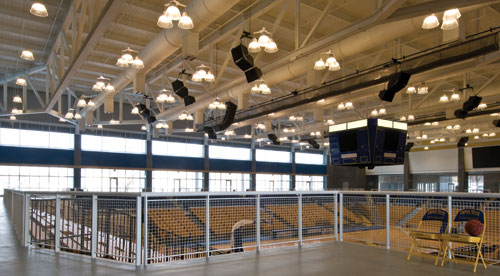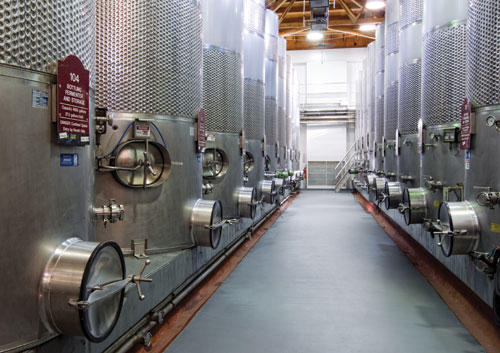Advancements and Applications in Resinous Floors and Walls
Case Studies
| Education Application Coppin State University, Baltimore, Maryland |
||
Coppin State University, a 52-acre campus in Baltimore, Maryland, unveiled its new $136-million, 246,000-square-foot Physical Education Complex in 2010. When plans were drawn up for the design of the basketball arena, polished concrete floors were specified for corridors, lobbies, and locker rooms. However, as work began, project managers were extremely unhappy with the unsatisfactory appearance of the first applications in the locker rooms and put a halt to the entire installation. Finding themselves in an unexpected situation, and drawing from numerous previous positive experiences with a resinous flooring systems manufacturer, the project superintendent reached out to it for guidance. The manufacturer guaranteed a long-lasting decorative floor system that could be installed quickly and at a fraction of the cost of the originally specified polished concrete. The manufacturer recommended a liquidapplied, urethane membrane for use on horizontal applications as a crack bridging isolation layer for the surface of the concrete substrate. The urethane membrane filled all cracks in the floor surface creating a smooth surface. The next step in the installation process a nominal 1/16-inchthick resurfacing system with a decorative stainresistant, durable, low-maintenance surface. A colored epoxy undercoat and a layer of colorful, broadcasted vinyl flakes, finished off with a clear urethane sealer, resulted in decorative, eyecatching floors in the complex’s new lobbies, concourses, walkways, restrooms, locker rooms, and pool observation deck. Facility planners and project managers were very satisfied by the quick and cost-effective remediation of the situation. |
| Transforming Production Facilities The Biltmore Winery, Asheville, North Carolina |
||
The Biltmore Winery at the Biltmore Estate in Asheville, North Carolina, is the most visited winery in the country. Each year, the winery harvests and processes 250 tons of grapes in its extensive production facilities, operating under a vigorous schedule that takes a heavy toll on the floors. Many floors in Biltmore’s production facilities were original to the building, and after 25 years of wear and tear, needed refurbishment. Additionally, the painted walls in the winery continually peeled in the harsh environment and had been repainted several times in an attempt to remedy the situation. The condition of Biltmore’s floors and walls not only troubled Biltmore management, but also presented aesthetic concerns, since many parts of the facility are open to public tours, welcoming thousands of wine enthusiasts each year. Biltmore management knew the positive benefits that new floors and walls would bring to the facilities and selected several resinous systems that could address all their needs. These systems helped transform both production facilities and improve work conditions. In 2008, the flooring manufacturer began by conducting a careful analysis of Biltmore’s needs and designed a multi-phase plan that included floor, wall and lining systems that would perform well in the production environment. When Biltmore planners were skeptical whether a wall coating could stand up to the conditions in their facilities, the manufacturer installed onsite samples to demonstrate the durability of the product. Convinced, Biltmore installed more than 8,800 square feet of flooring and 7,500 square feet of wall coatings between 2008 and 2010. A troweled polyurethane textured mortar system was installed in the tank room and grape processing areas. The highly resistant polyurethane mortar floor system provided a durable floor surface that could withstand heavy wear, impact, abrasion, thermal shock, and thermal cycling. These areas also received an application of epoxy wall glaze, which remedied all of the former wall problems by providing a smooth, easy-to-clean, chemicalresistant wall surface. The manufacturer installed troweled epoxy mortar flooring in Biltmore’s champagne bottling area and car exhibit space. The chemical and abrasion-resistant floors were sealed with a protective epoxy coating, which delivered a durable clean-line aesthetic with increased cleanability. The same troweled epoxy mortar was installed in a batching room and elevator lobby. In addition, the manufacturer completed outdoor work at the Biltmore facility. A weatherproof and protective polyureapolyurethane hybrid lining was applied to the outdoor welcome cabana and a rapid-installation polyurethane mortar system was used to complete an outdoor fountain basin. Odor control during installation was imperative for Biltmore, as were the needs for crews to work around stationary equipment and to complete some of the work at night, to accommodate Biltmore’s production and public tour schedules. “The floors look beautiful and I’m confident that they, along with the walls, will be there for many, many years,” says Bill Lynch, production manager. |
| Healthcare Application Huntsville Hospital, Alabama |
||
Huntsville Hospital in Huntsville, Alabama, the largest locally owned, not-for-profit hospital in the nation, with 881 acute care beds, envisioned its new 45,000-square-foot ER and Trauma Center by Chapman Sisson Architects to be cutting-edge in design and critically functional. The hospital had experienced problems with its vinyl tile flooring throughout other areas of its facility, especially in the ERs. Repairing cracked, stained and damaged vinyl involved shutting down much-needed, round-the-clock areas. In addition to the necessary floor repairs was the challenge of Betadine staining on Operating Room floors. Betadine, a necessary antiseptic chemical that leaves yellowish-brown stains on traditional vinyl tile and sheet goods, is a chronic problem in healthcare facilities. The design group specified a stylized, long-lasting, easy to maintain floor that would hold up to Betadine staining, remain ergonomic for staff members who spend hours standing and muffle the sounds from voices, wheeled carts, and throngs of visitors each day. A seamless urethane floor system infused with rubber aggregate was selected for its ergonomic and sound-reducing qualities along with stain resistance. An integral coving material was troweled along floor bases and up onto walls for a sanitary, low-maintenance system. There were no seams or joints and no waxing was required. The floors could also stand up to the heavy loads found in hospitals. Furthermore, if the floors were cleaned within eight hours of Betadine spills with a fast-acting, easy-to-use stain remover provided by the flooring manufacturer, no staining would occur. Warm earth tones were chosen to create a contemporary, non-sterile look. Swirling patterns combined with tweed colors created pathways to aid patients, staff, and visitors with wayfinding. Originally, the space that the new ER and Trauma Center now occupies was intended to be a parking deck and the concrete slab had already been poured. When design plans changed from parking deck to the new facility the architects were concerned about how this would affect the permanent flooring. The flooring manufacturer’s installation crews leveled the concrete. They then applied a patching mortar before installing the flooring system to allow for the best possible bond between substrate and floor. Since the new installation, an additional 25,000 square feet of resinous flooring have been installed in the “old” ER and Trauma Center at Huntsville. |
Conclusion
Resinous flooring has many advantages over traditional systems, such as vinyl tiles and sheeting, terrazzo, sealed concrete, and carpeting. It is durable, cleanable, safe, cost effective, and resistant to chemicals. With its versatile color palette, it also offers many custom design possibilities. Available in a number of configurations for applications ranging from healthcare, food and beverage, to sports facilities and corporate offices, it serves a multitude of markets. Design professionals should note that competent and professional installation is critical for a long-lasting successful floor and should evaluate the option of specifying a turnkey flooring system that includes installation.
 |
Stonhard is the unprecedented leader in manufacturing and installing high-performance epoxy and urethane floor, wall and lining systems. Stonhard’s seamless, long-wearing, and easy-to-clean systems are engineered to perform in both industrial and commercial environments without sacrificing design and innovative vision. www.stonhard.com |











